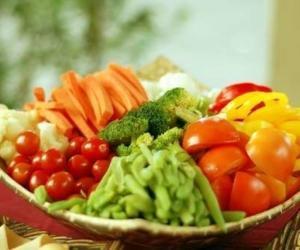Low FODMAP Diet: Stages and Foods To Eat

FODMAPs are naturally found sugar alcohols which are formed by a short chain of carbohydrates. Due to this, their complete absorption does not take place in the small intestine. The acronym is explained by the co-creator Sue Shepard as:
- Fermentable – Bacteria are responsible for their decomposition and fermentation in the large bowel.
- Oligosaccharides – “oligo” means “few” and “saccharide” means sugar. As the breakup suggests, they are formed when a chain of sugars is formed.
- Disaccharides – “di” means two. This is a combination of two sugar molecules (monosaccharides).
- Monosaccharides – “mono” means single. This is a single-sugar molecule.
- And
- Polyols – sugar alcohols low in calories.
Sources of FODMAPs
The FODMAP food group consists of short chain carbohydrates which are not completely absorbed. Some of these are:
Excess fructose
Fructose is a simple sugar that requires no digestion. The degree to which the decomposition of fructose happens varies with the activity of the sugar transporters. Since they are located in the walls of the small intestine, that is where the absorption of fructose happens.
Fructose has ill effects on the human body, if taken in excessive amount. As an end result of various studies, it was deduced that fructose was not absorbed completely in the small intestine. Instead, it was passed onto the large intestine. In the large intestine, the fermented fructose produces gases like hydrogen and methane, which result in diarrhoea, bloating and pain. The liver is the only organ responsible for the metabolism of fructose and if not kept in control, it can damage the liver.
Lactose
Lactose is a disaccharide which means that it is made up of two sugar units. Lactose needs to be broken down into individual sugar units by an enzyme called lactase before digestion. When there is a deficiency in the amount of lactase due to a variety of factors such as genetics, ethnicity, gut disorders, etc, lactose becomes a FODMAP.
Oligosaccharides
These consist of fructans and galacto-oligosaccharides. Due to the lack of enzymes in humans that can break these down, they are not digested. As a result, these are absorbed by the small intestine and can cause problems for individuals having IBS.
Polyols
Polyols are sugar alcohols whose absorption across the intestinal barrier is slow. Out of the total amount of polyols consumed, only about one-third is absorbed in the intestine. The most common types of polyols are mannitol and sorbitol. Among the two of them, the latter is often used as a low-calorie sweetener in sugar free products.
Some of the foods rich in the above constituents of FODMAP are:
- Excess Fructose: Apples, Pear, Mango, Honey, Watermelon, Corn Syrup
- Fructans: Artichokes, Garlic, Leek, Onion, Spring Onion, Shallots, Wheat, Rye, Barley, Inulin, lentils, Fructo-oligosaccharides
- Lactose: Dairy products like milk, custard, cheese
- Galacto-Oligosaccharides (GOS): Legumes like soy beans and kidney beans, Chickpeas and Lentils
- Polyols: Bakery items, Mints, Artificial sweeteners, Watermelon, Mushroom
Causes of IBS
Poor absorption of FODMAPs is one of the chief reasons of IBS. These FODMAPs are present naturally in the food. When these molecules reach the small intestine, they are poorly absorbed. The remaining are transferred to the large intestine, which shouldn’t have happened. Over there, the colonic microflora bacteria act upon it, which causes a series of problems.
In the end, this leads to fermentation of bacteria inside the FODMAPs. They draw in water and release gases like CO2(carbon dioxide), H2(Hydrogen) and CH4(Methane). These gases tend to expand and hence cause stretching and expansion of the intestine. And that is when the symptoms of IBS like abdominal pain, excess wind, bloating and distension of the abdomen, constipation, diarrhoea, changes in bowel habits and other gastro-intestinal problems are observed. Hence, the harmful effects of FODMAPs can have severe implications in some people.
Although the malabsorption of FODMAPs is a natural phenomenon that occurs in healthy people, it is only in IBS that gut symptoms are induced more readily.
Irritable Bowel Syndrome (IBS)
The severity of IBS can be understood by the fact that it not only persists for a long time, but it can also be recurring. This can also turn into a life-long gastrointestinal disorder. IBS is detected by abdominal pain, cramping, constipation alternating with diarrhoea, bloating and a change of bowel habit. The stats of many surveys have established the fact that more than one-tenth of the world suffers from IBS. And considering the world demographics, the numbers are above average in countries like Australia, the US and UK.
There can be a number of triggers for IBS symptoms such as foods, medicines, the presence of gas or stool, as well as emotional stress. The diagnosis of IBS is difficult too, as there are no particular tests to confirm the condition. The treatment protocol also differs from person to person. Some diet and lifestyle changes can help to improve the condition.
The exact causes of IBS are still unknown. It is often suggested that IBS occurs when there is a problem in the natural contraction movement of the muscles in the bowels. Due to this, they are unable to squeeze normally, which affects the movement of stools.
Low FODMAP Diet
A diet low in FODMAPs or completely devoid of it is gaining traction among people due to its multitude of advantages. Such a diet is known as FODMAP elimination diet and it is not a permanent thing. People follow this diet only to the point where the unabsorbed FODMAPS are absorbed and the harmful effects are negated. Another reason for the spike in its popularity is its acceptance by the medical fraternity as one of the most effective dietary therapies to prevent IBS.
The advantages are not limited to individuals with IBS, but such a diet is gaining popularity amongst the mass of people suffering from functional gastrointestinal disorder (FGID). Other diseases that have found it helping are frequent migraines which are caused by the items on the platter, small intestinal bacterial overgrowth (SIBO), health issues triggered by certain foods, certain auto-immune conditions/diseases like multiple sclerosis, rheumatoid arthritis or eczema, fibromyalgia.
A number of studies were conducted on patients with IBS and the success rate of following a low FODMAP diet was almost 75%. There are clinical trials that show a low FODMAP diet gives positive results, when included in the treatment protocol for IBS.
Stages of the low FODMAP Diet
The severity of the problem also lies in the unpredictability and erratic nature of the malady. It affects each person differently and hence, the cures need to be unique as well. While in some individuals ,the symptoms may be triggered by one or two types of FODMAPs, in others, it may be due to sensitivity to all five FODMAPs. Foods should only be restricted if they contribute to the symptoms.
The low FODMAP diet consists of two phases. This dietary abstention should not happen except under the supervision of a dietician’s consultation. He can give you a unique diet to follow looking at the symptoms.
As mentioned earlier, this diet is not a permanent diet. Removing FODMAP completely from the diet for a prolonged period of time could lead to severe medical problems in a person as many high FODMAP foods are integral for stimulating the growth of beneficial bacteria in the gut.
Phase 1
During the initial stages, an experienced dietician will guide you about the restriction to be placed in terms of intake of foods containing FODMAP. The duration of this phase is 4 to 6 weeks. These foods will be suggested by the dietician along with necessary alternatives to ensure sufficient nutritional intake. The individual should have a smooth transition from phase 1 to phase 2 in consultation with the expert, once the proper symptom responses are observed.
Phase 2
The second phase incorporates small amounts of some FODMAP foods which were completely cut-off in the initial phase. The expert keeps a keen watch on the symptoms to ensure that they do not return with the reintroduction of FODMAP. The diet is tailored to suit each individual and the results will help to establish a long term diet. This diet should lower the problems caused by eating FODMAPs for the individual. It should also not be as FODMAP-restricted as was the case in the first phase of the diet.
Low FODMAP foods
Following are some of the common foods containing low amount of FODMAPs. These are considered as the ‘safe foods’ that can be consumed while following a low FODMAP diet. The list varies from individual to individual and should be followed strictly only under the guidance of a dietician and the dietician should have experience in a low FODMAP diet.
- Vegetables: Beans, Broccoli, Cucumber, Carrots, Beetroot, Bell peppers, Ginger, Potato, Sweet potato, Cabbage, Tomato, Sweet corn, Eggplant, Lettuce, Zucchini
- Legumes: Baked beans, Soya beans, Chickpeas, Lentils, Tofu, Red kidney beans, Split peas, Hazelnuts, Almonds, Peanuts
- Fruits: Bananas, Bilberries, Mandarin, Blueberries, Pineapple, Cranberry, Dragon fruit, Grapes, Guava, Raspberry, Passion fruit, Kiwifruit, Lemon, Lime, Orange, Papaya, Strawberry
- Meats, Poultry and Meat Substitutes: Beef, Lamb, Chicken, Turkey, Pork, Cold cuts / deli meat / cold meats such as ham and turkey breast
- Fish and Seafood: Mussels, Canned tuna, Haddock, Fresh fish like Cod, Plaice, Tuna, Prawns, Salmon, Trout, Seafood like Crab, Lobster, Oysters, Shrimp
- Cereals, Grains, Breads, Biscuits, Pasta, Nuts and Cakes: Wheat free breads, Gluten free breads, Wheat free or gluten free pasta, Chestnuts, Brazil nuts, Buckwheat, Buckwheat noodles, Almonds, Buckwheat flour, Egusi seeds, Biscuit (savoury, shortbread), Brown rice/whole grain rice, Chips, plain/potato crisps, Cornflakes, Oatcakes, Coconut milk, Coconut cream, Coconut flesh, Corn tortillas, Millet, Oats, Peanuts, Porridge and Oat based cereals, Popcorn, Pretzels, Basmati rice, Brown rice, Rice noodles, White rice
- Seeds: Sunflower seeds, Chia seeds, Pumpkin seeds, Poppy seeds Sesame seeds
- Condiments, Dips, Sweets, Sweeteners and Spreads: Aspartame, Barbecue sauce, Capers in vinegar, Capers, Fish sauce, Golden syrup, Glucose, Jam/jelly, strawberry, Maple syrup, Marmalade, Marmite, Mayonnaise – ensuring no garlic or onion in ingredients, Mustard, Garlic infused oil, Peanut butter, Rice malt syrup, Saccharine, Tamarind paste, Shrimp paste, Soy sauce, Oyster sauce, Sweet and sour sauce, Sucralose, Wasabi, Worcestershire sauce, Dark chocolate, Milk chocolate, White chocolate
-
Drinks and Protein Powders: Limited intake of alcohol is advised as it tends to irritate the gut,
- Coffee: Espresso coffee, regular or decaffeinated, black; Espresso coffee, regular or decaffeinated, with up to 250 ml lactose free milk; regular or decaffeinated, black, Instant coffee, regular or decaffeinated, with up to 250ml lactose free milk. Drinking chocolate powder: Espresso, regular, black, 125ml and safe fruits only, Lemonade ,
- Protein powders: Pea protein, Egg protein, Rice protein, Whey protein isolate, Sacha Inchi protein, Soya milk made with soy protein, in low quantities as aspartame and acesulfame k can be irritants,
- ‘Sugar’ free fizzy drinks / soft drinks / soda that do not contain HFCS such as lemonade, cola and diet coke. Limit intake due to these drinks being generally unhealthy and can cause gut irritation.
- Tea: Fruit and herbal tea, Chai tea, Black tea, Green tea, Peppermint tea, White tea
- Fruit juices: Banana, Grapefruit, Pineapple, Cranberries
- Vegetable Juices: Turnips, Tomato, Spinach, Pumpkin, Broccoli
-
Dairy Foods and Eggs:
- Tofu – drained and firm varieties,
- Cheese: Cheddar, Cottage, Feta, Camembert, Mozzarella, Ricotta, Swiss;
- Lactose free yoghurt,
- Milk: Hemp milk, Lactose free milk, Almond milk, Oat milk, Rice milk;
- Sorbet, Soy protein (avoid soya beans), Tempeh, Whipped cream, Parmesan, lactose free ice cream

















